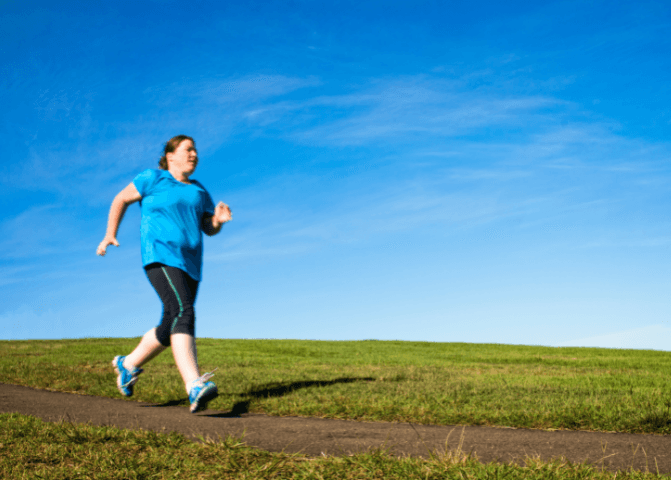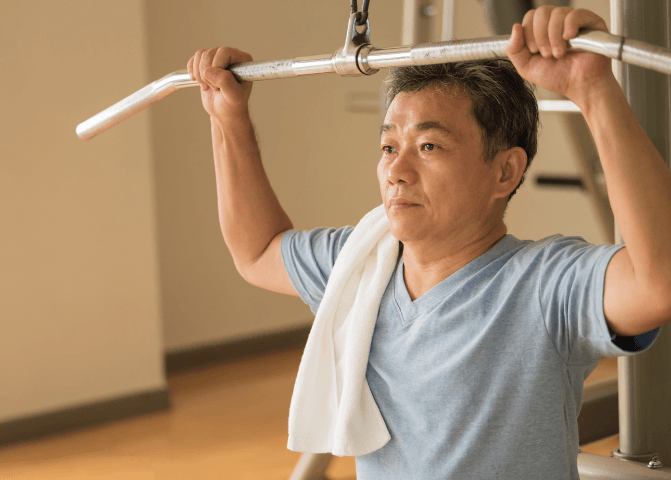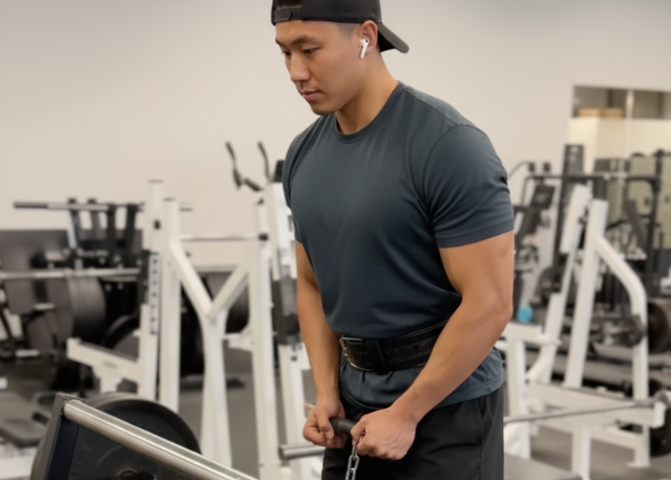08/10/2021
Top Cardio And Resistance Exercises For Diabetes
Table of Contents
- What is Diabetes and Can Exercise Help?
- Can You Reverse Diabetes With Diet and Exercise?
- How Does Exercise Help With Diabetes?
- The 3 Best Cardio Exercises for Diabetes
- Walking for Diabetes
- Jogging for Diabetes
- Cycling for Diabetes
- The 4 Best Resistance Exercises For Diabetes
- Deadlifts
- Lat Pulldowns
- Bench Press
- Barbell Squats
- Exercise Plan In Managing Type 2 Diabetes
Exercises For Diabetes – What is it? How exercise can help and finding the right exercise options for managing diabetes.
Diabetes is a chronic condition that affects millions of people worldwide. If left untreated, diabetes can lead to organ damage, vision loss, heart disease, and more.
The good news is, there are positive behaviors that can help us manage diabetes and even reverse the condition. One such example is regular exercise.
Let’s take an in-depth look at diabetes, what role exercise plays, and what that means for you.
What is diabetes and can exercise help?
Diabetes is a chronic condition that impacts how your metabolism works. According to statistics, one in twenty people in Australia had diabetes in 2017-2018 1.
When you eat food, carbohydrates get broken down into simple sugar (glucose) molecules. The sugar enters your bloodstream, which signals the pancreas to release insulin to absorb the glucose and shuttle it to different cells of the body 2.
Diabetes occurs when one of two things happens 3:
- Your pancreas cannot produce enough insulin
- Your body cannot use the insulin your pancreas releases
Regardless of what the source of the problem is, diabetes leads to chronically elevated blood sugar levels, which increases the risk of 3:
- Cardiovascular disease
- Kidney problems
- Vision loss
- Impaired nerve signaling
So far, researchers haven’t found a cure for diabetes. The best we can hope for is proper management of the condition to continue living a mostly normal life. Check out our quick diabetes treatment guide for some actionable ideas.
One way to manage diabetes, especially if a person has had the condition for a long time, is to inject insulin regularly 4. Exogenous insulin allows patients to manage their blood sugars and reduce the risk of long-term health consequences of diabetes.
The good news is that we can employ other tactics to manage diabetes better, one of which is regular physical activity.
Can you reverse diabetes with diet and exercise?
Although we don’t have a cure for diabetes, there have been successful cases of reversing the condition through better lifestyle choices that reduce body weight to target levels.
Reversing diabetes doesn’t mean you’ve cured the condition. Instead, it means that you can reach and maintain normal blood sugar levels without medication, which is also a huge success 5. But to maintain that reversed state, you need to continue to make good lifestyle choices and monitor your blood sugar regularly.
How Does Exercises For Diabetes Help?
Exercise helps patients manage diabetes in two significant ways. First, exercise requires glucose to produce adenosine triphosphate (ATP), which fuels every process inside the body 6. When we start training, ATP demands increase rapidly, which leads to glucose breakdown. In turn, the glucose breakdown lowers blood sugar levels and keeps them in the normal range.
Blood Sugar Management
Activities like aerobic exercise are particularly beneficial because they require large amounts of energy, which means greater glucose breakdown and healthier blood sugar levels. Aerobic exercise is also good for weight loss and body fat percentage reduction 7. In turn, that can improve cardiovascular health and lower cholesterol levels 8.
Insulin Sensitivity
The second way exercise helps with diabetes is by improving insulin sensitivity – a measure of how sensitive your body’s cells are to the hormone 9. Higher insulin sensitivity means that your body needs smaller amounts of the hormone to carry out its routine tasks and maintain normal blood sugar levels. As a result, your pancreas needs to produce less of the hormone for you to stay healthy. So, if you have diabetes, better insulin sensitivity can lead to smaller insulin doses and might eventually lead to normal blood sugar levels without medication.
Resistance training is beneficial because it involves a larger percentage of our skeletal muscle tissue, which leads to more significant improvements in insulin sensitivity 10. In essence, we improve the body’s ability to use glucose for energy without taxing the pancreas as much.
Regular resistance training is also excellent because combining it with a calorie-restricted diet leads to fat loss and maintenance of muscle mass 11. So, aside from improving insulin sensitivity, resistance training is also good for our cardiovascular health, cholesterol, and other health markers 8.
The 3 Best Cardio Exercises For Diabetes
Every aerobic activity will help you manage the condition better, so long as you do it consistently. What matters more is that you enjoy the type of exercise and can do it without getting injured or burned out.
Walking for diabetes
A fantastic way to start aerobic exercise is by walking more each day. Walking is a simple, natural, and non-intimidating way to become more active. No matter who you are or what your fitness level is, you can go for a walk, even if it lasts for ten minutes.
Walking is good because it burns some calories, aids digestion, and benefits our metabolic and cardiovascular health 12. Plus, walking is criminally underrated for the brain. It can clear our minds, improve our mental health, and bring a sense of well-being.
The best part is, walking doesn’t take much to do, and you can incorporate it into your life. For example, if you commute by bus, get off one stop earlier, and walk the remaining distance. When having to choose between an elevator and stairs, pick the latter.

Jogging for diabetes
Light jogging is also an excellent aerobic activity for people with diabetes because it’s suitable for beginners and brings a sense of euphoria that can help patients deal with their condition. As little as ten to twenty minutes of light jogging can burn tens of calories and improve blood sugar levels.

Cycling for diabetes
Riding a bike is another beginner-friendly and low-impact activity that raises your heart rate, helps you manage your blood sugar levels, and has other positive health effects. The activity is also fun and allows you to travel around town for free. For example, instead of taking your car everywhere, grab your bike and use it when possible.
You can also go out for leisurely bike rides with your friends or family members, explore your town and surrounding areas, and soak up some vitamin D.

The 4 Best Resistance Exercises For Diabetes
Resistance training is valuable for managing diabetes because it offers many of the same benefits as cardio. This type of exercise burns through glucose, allowing you to maintain healthy levels more easily. Plus, resistance exercise builds muscle mass, which positively impacts your insulin sensitivity 10.
Deadlifts
The deadlift is a full-body exercise where you lift a weight off the floor. In doing so, you train your entire posterior chain: hamstrings, glutes, and entire back. Your arms, shoulders, quadriceps, abdominals, and chest muscles also work hard.
Doing the deadlift is beneficial because the movement expends plenty of calories, makes us more functional, and can positively impact insulin sensitivity.
If you can’t do traditional deadlifts, good alternatives include:
- Sumo deadlifts
- Trap bar deadlifts
- Romanian deadlifts
- Single-leg Romanian deadlifts

Lat Pulldowns
The lat pulldown is a beginner-friendly exercise that trains your back, biceps, and forearms. The movement is fun to do and easy to learn.
When done correctly, the lat pulldown develops the latissimus dorsi, the upper body’s largest muscle. Lat pulldowns also build our rhomboids, erector spinae, trapezius, infraspinatus, rear deltoids, biceps, and brachialis.
Similar to deadlifts, lat pulldowns are great for burning through some glucose and improving insulin sensitivity.

Bench Press
The bench press is among the most popular resistance exercises out there, and for good reasons. Bench pressing regularly builds up your chest, shoulders, and triceps. The movement also improves upper body stability and makes us stronger.
Like lat pulldowns and deadlifts, the bench press is good because it trains a range of muscle groups, burns through glucose, and contributes to healthy insulin sensitivity.
The best part is, you can do variations of the bench press or swap it for less intimidating movements if you’re new to the gym. Examples include:
- Dumbbell bench press
- Incline press
- Seated machine chest press

Barbell Squats
The barbell squat is often referred to as the king of all exercises. The movement primarily trains our quadriceps – the second largest muscle inside the body. Squats also build our glutes, train our hamstrings, and involve the upper body, which keeps us stable and upright.
As a whole-body exercise, barbell squats burn plenty of energy, which can help us maintain healthy blood glucose levels. In addition, squats can contribute to better insulin sensitivity because the movement involves many large muscles in the body.
If barbell squats feel too challenging, you can begin with simpler alternatives, such as:
- Bodyweight squat
- Bodyweight jump squat
- Goblet squat
- Resistance band squat

Exercise Plan In Managing Type 2 Diabetes
It’s best to exercise daily, even for five to ten minutes. Doing so can help you build momentum and make exercise a non-negotiable part of your day. Plus, daily exercise will have a positive impact on your blood glucose and insulin sensitivity.
You also don’t have to start with intense exercise. Low to moderately-intense training can be a great start. For example, you can do low-intensity activities like walking or jogging. You should also introduce resistance training to build muscle mass, manage blood glucose better, and boost your insulin sensitivity 10. We recommend moderately intense training with the goal of doing at least ten repetitions per set.
Sample weekly exercise plan for diabetes
Monday – treadmill walking (5 minutes) + barbell squats (10 minutes)
Tuesday – walking outdoor + bench pressing (10 minutes)
Wednesday – riding a bike (10 minutes) + lat pulldowns or inverted rows (5 minutes)
Thursday – Jogging (5 minutes) + deadlifts (10 minutes)
Friday – bench pressing (10 minutes) + lat pulldowns (10 minutes)
Saturday – treadmill walking (10 minutes) + barbell squats (10 minutes)
Sunday – walking outdoor + deadlifts, bench press, and lat pulldowns (15-20 minutes)
Adequate water intake is also essential. Having water before, during, and after training is beneficial for optimal exercise performance 13. As a rule of thumb, men should drink around 3.5 liters of water daily, and women – 2.5 liters.
Proper nutrition is also essential, especially before and after training. Some combination of complex carbs and protein will do best. Eating these nutrients before exercise will provide you with energy to work hard and building blocks to prevent excessive muscle protein breakdown. A good post-workout meal will kickstart the recovery process, allowing you to build muscle more effectively.
References
- Diabetes – Australian Institute of Health And Welfare (23 Jul 2020)
- Carbohydrate Metabolism
- Wu Y, Ding Y, Tanaka Y, Zhang W. Risk factors contributing to type 2 diabetes and recent advances in the treatment and prevention. Int J Med Sci. 2014;11(11):1185-1200. Published 2014 Sep 6. doi:10.7150/ijms.10001
- Insulin – Diabetes Australia
- Hallberg SJ, Gershuni VM, Hazbun TL, Athinarayanan SJ. Reversing Type 2 Diabetes: A Narrative Review of the Evidence. Nutrients. 2019;11(4):766. Published 2019 Apr 1. doi:10.3390/nu11040766
- Baker JS, McCormick MC, Robergs RA. Interaction among Skeletal Muscle Metabolic Energy Systems during Intense Exercise. J Nutr Metab. 2010;2010:905612. doi:10.1155/2010/905612
- Willis LH, Slentz CA, Bateman LA, et al. Effects of aerobic and/or resistance training on body mass and fat mass in overweight or obese adults. J Appl Physiol (1985). 2012;113(12):1831-1837. doi:10.1152/japplphysiol.01370.2011
- Wing RR, Lang W, Wadden TA, et al. Benefits of modest weight loss in improving cardiovascular risk factors in overweight and obese individuals with type 2 diabetes. Diabetes Care. 2011;34(7):1481-1486. doi:10.2337/dc10-2415
- Borghouts LB, Keizer HA. Exercise and insulin sensitivity: a review. Int J Sports Med. 2000 Jan;21(1):1-12. doi: 10.1055/s-2000-8847. PMID: 10683091.
- Ismail AD, Alkhayl FFA, Wilson J, Johnston L, Gill JMR, Gray SR. The effect of short-duration resistance training on insulin sensitivity and muscle adaptations in overweight men. Exp Physiol. 2019 Apr;104(4):540-545. doi: 10.1113/EP087435. Epub 2019 Feb 10. PMID: 30697876.
- Miller T, Mull S, Aragon AA, Krieger J, Schoenfeld BJ. Resistance Training Combined With Diet Decreases Body Fat While Preserving Lean Mass Independent of Resting Metabolic Rate: A Randomized Trial. Int J Sport Nutr Exerc Metab. 2018 Jan 1;28(1):46-54. doi: 10.1123/ijsnem.2017-0221. Epub 2018 Jan 24. PMID: 28871849.
- Rippe JM, Ward A, Porcari JP, Freedson PS. Walking for health and fitness. JAMA. 1988 May 13;259(18):2720-4. PMID: 3282085.
- Susan M. Shirreffs, PhD, The Importance of Good Hydration for Work and Exercise Performance, Nutrition Reviews, Volume 63, Issue suppl_1, June 2005, Pages S14–S21
Recommended reading
Search for a specific topic or filter by categories to find information on what you need to know on the full Medmate Journal


The Belt Squat RDL is a Game-Changer
Looking to build a stronger, more powerful lower body while minimizing risk? The Belt Squat RDL might just be the exercise you’ve been missing. This unique movement, often overlooked, offers…
